

Thanks to Carlo Lippolis who provided the text and photographs for this year's page.
See Old Nisa Bibliography: Publications of Centro Scavi di Torino and contributions of the members of the Italian Expeditions to Nisa.
From 16 August through 15 October 2007, a joint Italo-Turkmen team conducted research in Old Nisa in the southern part of the citadel. The mission was carried out by the Centro Ricerche Archeologiche e Scavi di Torino in collaboration with the Italian Ministry of Foreign Affairs and the National Department for the Protection, Study and Restoration of Historical and Cultural Monuments of Turkmenistan.
| Topographic plan of Old Nisa with new excavation area, 2007 | |
 |
|
| Click on picture to enlarge | Map by C. Lippolis |
In the southeast area, two soundings were opened. In the first one, a small distance from the eastern fortification walls, the excavations revealed an area – probably opened – in which food commodities were stored, seemingly attested by 20 large fragmented khums (jars) on the ground. The entire area had been prepared by leveling the natural soil and depositing a preparation of earth, gyps and stones that served as a base for the compacted clay floor. Apart from a very small piece of wall in pakhsa, no traces of masonry structures were discovered in this area.
|
Fig. 1. Old Nisa. Khums in SE area, from north |
Fig. 2. Old Nisa. SE area, from south |
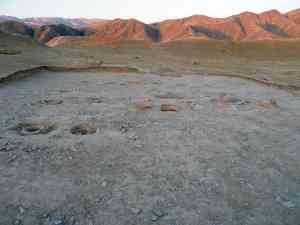 |
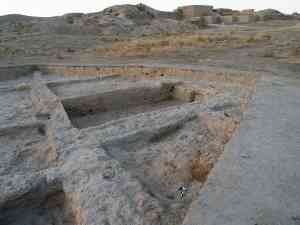 |
| Click on pictures to enlarge | Photos by C. Lippolis |
Further to the west, close to an old (1966) JuTAKE trench, an area of 20 x 13 meters was opened; the thickness of the cultural layers at this point is approximately 1.4-2.0 meters. Here four different cultural levels are recognizable. Of the more recent phase of utilization of the area (I) are seven large khums for storage, but unfortunately they are fragmented. To the lower levels (II-IV) belong badly preserved structures with walls of pakhsa or walls made with a thick stratum of mortar and a filling of clay, pottery shards, pebbles and fragments of mud bricks. These constructions were in use for a long while and have endured various restorations. As their walls were not able to support a heavy roof, perhaps these structures just delimited open spaces whose purpose is not yet clear. The aim of the next campaign will be to widen investigation in the area to define the complete plan of the structures and their exact chronology and purpose.
|
Fig. 3. Old Nisa. SE area general view at the end of 2007 excavation |
|
| Click on picture to enlarge | Photo by V. Messina |
At the opposite corner of the citadel and approximately 40 meters to the southwest of the Round Hall we also opened a sounding of 35 x 25 meters in size. Here the excavation brought to light wall masonries belonging to a domestic-residential (?) building. The plan of the building, oriented north-south, is still not complete and the only established limit of the complex is the southern one. It appears we can recognize at least three phases of utilization of the area: two are Arsacid while the late one probably belongs to the Islamic period. The walls are made of the standard form mud-brick of the Parthian period in Nisa (40-42 cm each side and 12 cm in thickness).
|
Fig. 4. Old Nisa. SW area, general view from south |
Fig. 5. Old Nisa. SW area, room 9 |
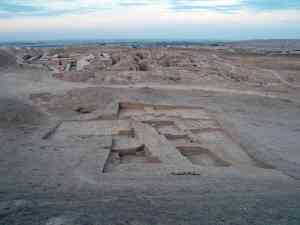 |
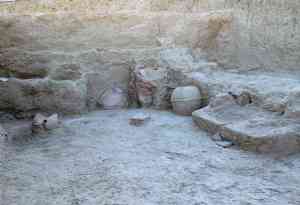 |
| Click on pictures to enlarge | Photos by C. Lippolis |
The plan of the building is rather irregular with a double row of small rooms, oriented north-south, that represents the core of the house. To the west and east were identified other rooms (unfortunately the walls are very poorly preserved) and courtyards. These will be object of surveying in future campaigns. The presence of a residential (?) building in Old Nisa arouses great interest, but at the moment it is not possible to determine either its precise purpose or its chronology (Old Nisa “early, middle or late” Parthian phases?) which remain to be ascertained.
| Fig. 6. Old Nisa. SW area, Islamic jar from the upper layers of room 8 | |
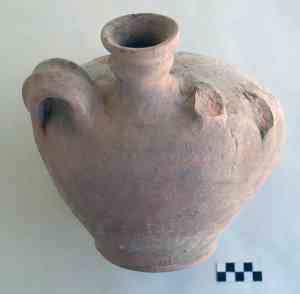 |
|
| Click on picture to enlarge | Photo by C. Lippolis |
The excavation team's final report is forthcoming, planned for publishing in early 2008.
| Click on picture to enlarge | Photo by Bruno Radicati |
|
Front row: Maja, Yalgeren, Jennet, Fiorenza Celi, Roberta Menegazzi,
Begench (kneeling),
Andrea Squitieri, Claudio Fossati, Carlo Lippolis Second row: Eziz, Alessandro Battezzati, Marco Capardoni, Eleonora Pappalardo, Vito Messina In front (below) our mascot: Tusik |
|
Antonio Invernizzi, scientific director, professor at University of
Turin
Carlo Lippolis, field director, University of Turin (Dept. SAAST) and
Centro Scavi di Torino
Muhammed Mamedov, director of NDPRT
Kurban Balliev, director of the Nisa Reserve
Vito Messina, archaeologist, Centro Scavi di Torino
Roberta Menegazzi, archaeologist, Centro Scavi di Torino
Claudio Fossati, architect, University of Turin
Eleonora Pappalardo, archaeologist, University of Catania
Alessandro Battezzati, student in Archaeology, University of Turin
Marco Capardoni, student in Archaeology, University of Turin
Andrea Squitieri, student in Archaeology, University of Turin
Fiorenza Celi, student in Archaeology, University of Turin
This page last updated 23 Feb 2021